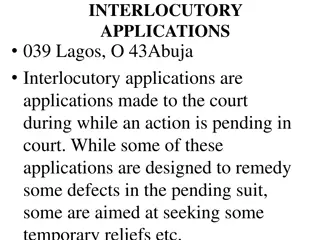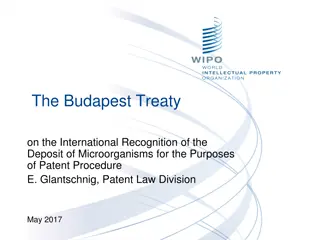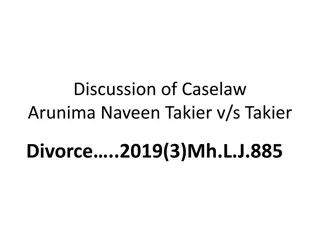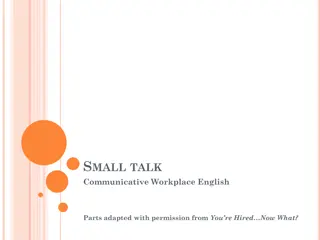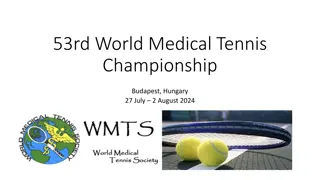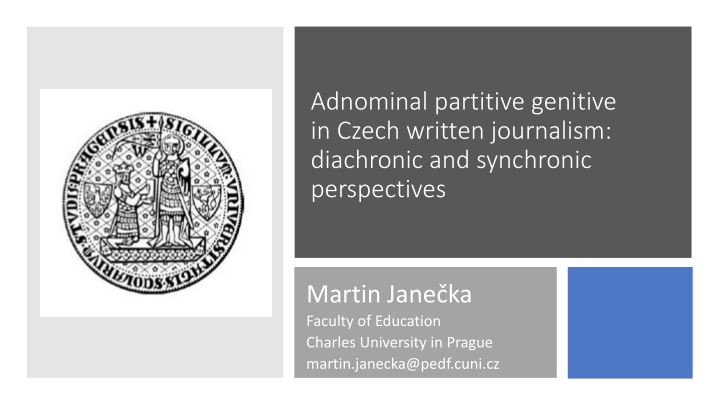
Czech Adnominal Genitive in Written Journalism: Perspectives by Martin Janečka
Explore the diachronic and synchronic perspectives of adnominal partitive genitive in Czech written journalism through the insightful contributions of various scholars. Gain an understanding of the evolution of the genitive case in Czech, its adnominal usage, and its role in different syntactic functions, providing valuable insights for language enthusiasts and researchers alike.
Download Presentation

Please find below an Image/Link to download the presentation.
The content on the website is provided AS IS for your information and personal use only. It may not be sold, licensed, or shared on other websites without obtaining consent from the author. If you encounter any issues during the download, it is possible that the publisher has removed the file from their server.
You are allowed to download the files provided on this website for personal or commercial use, subject to the condition that they are used lawfully. All files are the property of their respective owners.
The content on the website is provided AS IS for your information and personal use only. It may not be sold, licensed, or shared on other websites without obtaining consent from the author.
E N D
Presentation Transcript
Adnominal partitive genitive in Czech written journalism: diachronic and synchronic perspectives Martin Jane ka Faculty of Education Charles University in Prague martin.janecka@pedf.cuni.cz
Introduction Fundamental contributions by V. Skali ka (2004 [1960], 767; [1963], 859 etc.), K. Hausenblas (1958), Lamprecht losar Bauer (1986, 361) and O. Uli n (2003) indicate that the genitive in Czech has gradually profiled as an adnominal case (the syntactic function of an incongruent attribute); Its use in adverbial positions (= an object) is weakening.
A diachronic and synchronic view of Czech in particular, including dialectal forms. Languages close to Czech typologically (other Slavic languages, especially Russian), geographically (German), adopting words or even whole connections (German and English). Among other things functions of adnominal structures specific to their lexical placement: genitive idioms.
Case in Czech (and Slovak) Uli n Veselovsk (2017): case = grammatical category, corresponds to the relationship between the noun and the next expression in the sentence by which this noun is controlled. Czech (inflected language): seven cases for singular and plural (vocative is separated from the case definition). To express the fact that the phenomenon named by the noun enters specific relationships with other events, the noun has accusative, genitive, dative, local and instrumental cases (indirect case) and nominative case (direct case).
and more Parts of sentence: the function which is realized by the case form: case of the subject (usually nominative), cases of the object (cases without prepositions), cases of adverbs or cases of the attribute (esp. genitive). The most common case of the object of a transitive verb in Czech is accusative = direct object. If the verb has a second object, it is mostly dative. Direct/indirect object, subject or attribute = description of the syntactic functions of case forms of the noun = their functions on the surface syntactic level. To describe the semantic functions of case forms = functions in the deep structure of the sentence terms such as agent, patient, and others.
Adnominal Genitive (1) a noun in the position of a postponed incongruent attribute; (2) a noun belonging to a verb or an adjective, either directly or as part of the prepositional construction: (1) trest smrti = punisment of death, kl e od bytu = keys from the apartment; (2) litovat inu = to regret an act, vid t bez br l = to see without glasses, pln v na = full of wine, etc. (Karl k, 2017). Adnominal genitive : grammatically characterized by a single feature, a position by another noun that is superior to it and that requires it as a facultative addition. Differrent types of the adnominal genitive: genitive of affiliation, the genitives of the bearer of the event/patient, the genitive of the possessor, the genitive of species affiliation, the genitive of kind, properties and measure, the genitive of content, the genitive of measured content etc.
Karlk 2000: semantic classification 1) genitiv agentn (subjektov ) zp v pt k 2) genitiv patientn (objektov ) rozbit v zy 3) genitiv p ivlast ovac (posesivn ) zahrada na eho souseda 4) genitiv p in le itosti koruna stromu 5) genitiv nositele vlastnosti sm nitelnost koruny 6) genitiv vlastnosti lov k vesel mysli 7) genitiv autorsk rom n Milana Kundery 8) genitiv produktu autor rom nu ert 9) genitiv vysv tlovac (explikativn ) kor lky zub 10) genitiv definuj c povinnost vd nosti 11) genitiv dedika n ( estn ho n zvu) most Palack ho 12) genitiv stup ovac (augmentativn , hebrejsk ) kniha knih 13) genitiv kvantifikovan ho p edm tu (partitivn ) kus cukru 14) genitiv zobrazovan ho p edm tu obraz prezidenta 15) genitiv asov narozen 5. ledna
Partitive and Enumerative The partitive and enumerative are also treated as adnominal genitives, although these are not standard adnominal genitives numerals take the position of the determining noun, but they have a substantive inflection, e.g., kus plechu (a piece of sheet metal) or stovka most (a hundred bridges) etc. The partitive genitive is governed by a noun with a quantifying meaning (kus plechu a piece of sheet metal ); its special case is the enumerative, i.e., the genitive of the counted object after basic definite and indefinite numerals (e.g., est g l six goals , n kolik hr several players ).
These genitives are separated because of their partitive, enumerative semantics, different from other groups of adnominal genitives + because of the susceptibility of the determining member to another part-of-word class.
This functional profiling of the genitive case is one of the manifestations of a wider development process that affects the entire case system of Czech and which consists in suppressing the surface semantics of the case, e.g., partitivity (the type nabral vody = he took water , meaning a little ), On the contrary, it consists in the strengthening of more abstract semantics, or the tendency for individual cases to be profiled for the fulfilment of very specific syntactic functions (subject, attribute, object). The case system thus tends towards a formalization that is to some extent parallel to the processes that had already taken place earlier in the Romance and Germanic languages of Western Europe. These phenomena: the background of what R. Jakobson (1936, 269) already calls the decomposition of the system of case opposites.
Methods and materials The relationship between the verb and nominal parts of speech is to a large extent bound by style + the oldest journalistic texts date back to the 1840s, the analysis of the development of the adnominal genitive encounters certain material difficulties. Examining the development of this type of genitive in two different series of texts: 1) in journalistic texts from three relatively recent historical periods (from 1848 1860, 1882 1885 and 1915), 2) journalistic texts published in the years 1950, 1970 and 2000; the scope of each sample was set at 20 000-word forms. The sample of the latest texts from 2000 was limited using the Czech national corpus (syn2013pub).
Diachronic view 1882 1885 % abs. po et 8,7 79 18,02 164 7,72 44 20,52 194 1,67 24 0 5 0 0 0 10 0,51 12 0,39 7 0 4 10,68 78 0 0 9,65 74 22,14 141 SUB OBJ POS P IN NOS AUT PROD DED ZOBR VLAST EXPL DEF STUP PART AS 1848 1860 abs. po et 68 140 60 159 13 0 0 0 4 3 0 83 0 75 172 1915 abs. po et 105 214 22 302 18 0 0 8 4 4 7 121 0 66 75 % 9,39 19,62 5,27 23,11 2,87 0,65 0 1,22 1,43 0,86 0,45 9,32 0 8,9 16,91 % 11,08 22,62 2,33 31,94 1,9 0 0 0,85 0,42 0,42 0,74 12,79 0 6,98 7,93
Synchronic view 1950 1970 2000 % % % abs. po et abs. po et abs. po et SUB OBJ POS P IN NOS AUT PROD DED ZOBR VLAST EXPL DEF STUP PART AS 21 449 11,9 25,3 204 348 12,5 21,3 123 218 22 557 20 10,7 18,9 1,9 48,3 1,7 0,6 0 0 0 0 786 23 44 44,2 1,3 2,5 829 40 16 50,7 2,4 1 0 7 0 4 0 0 1 0 0 0 0 14 7 1 0 151 0,8 0,4 0,1 11 0 0 0 0,7 0,3 0 0 0 0 0 0 0,1 11,9 8,5 129 7,9 137 0 0 0 0 0 0 77 14 4,3 0,8 58 11 3,5 0,7 50 14 4,3 1,2
Conclusion Based on the data analysis, it was found that in the journalism of the 19th century there is already a strong tendency to prefer various semantic types of the adnominal genitive (e.g., belonging, defining or partitive) VS. some other semantic types of the genitive were peripheral (e.g., grading, product or dedicative). Especially in journalism between 1848 and 1915, an increase in various actant subtypes of the adnominal genitive was observed, which is associated with the formalization of sentence structure in Czech, or with functional case specialization.
The analysis of the data showed that it is possible to observe a significant decrease in the partitivity expressed by the adnominal genitive in Czech journalism. The highest frequency is detectable in the oldest examined texts, the lowest frequency in the most recent examined texts VS. especially in Moravian dialects (spoken, not written Czech), the partitive genitive is still alive today ( ipkov 1993, 75).
References Breu, Walter. 2020. "Partitivity in Slavic-Romance language contact: The case of Molise Slavic in Italy". Linguistics, vol. 58, no. 3, 837-868. https://doi.org/10.1515/ling-2020-0092 Dalewska-Gre , H. 2002. J zyki s owia skie. 2. vyd. Warszawa: Wydawnictwo Naukowe PWN. Fischer, Susann. 2003. Partitive vs. Genitive in Russian and Polish: an empirical study on case alternation in the object domain. In Fischer, Susann van de Vijver, Ruben Vogel, Ralf (eds.). Experimental studies in linguistics 1. Linguistics in Potsdam 21, 73 89. Potsdam: Univ.-Verl. Hausenblas, Karel. 1958. V voj p edm tov ho genitivu v e tin . Praha, SAV. Jakobson, Roman O. 1936. Beitrag zur allgemeinen Kasuslehre. In Travaux du Cercle linguistique de Prague, vol. 6. Prague: Jednota eskoslovensk ch matematik a fysik , 240 288. Reprinted in Selected Writings, II. Word and language (1971). Hague: Mouton. Jane ka, Martin. 2010. Syntax a s mantika genitivu adnomin ln ho v sou asn e tin . Master thesis. Olomouc: Faculty of Arts, Palacky University. Lamprecht, Arno t losar, Du an Bauer, Jaroslav. 1986. Historick mluvnice e tiny. Praha: St tn pedagogick nakladatelstv . Ser ant, Ilja A. 2021. "Typology of partitives". Linguistics, vol. 59, no. 4, 881 947. https://doi.org/10.1515/ling-2020-0251 Skali ka, Vladim r. 1960. V voj jazyka. Praha: St tn pedagogick nakladatelstv . Reprinted in Skali ka, V. Souborn d lo. T i svazky (2004 2006). Praha: Karolinum. Skali ka, Vladim r. 1963. Typologie a komparatistika. In B. Havr nek et al. (eds.) eskoslovensk p edn ky pro V. mezin rodn sjezd slavist v Sofii. Praha, 41 45. Reprinted in Skali ka, V. Souborn d lo. T i svazky (2004 2006). Praha: Karolinum. ipkov , Milena. 1993. Stavba v ty v mluven ch projevech: syntax han ck ch n e . Jino any: H&H. Uli n , Old ich. 2003. K deflektiviza n m tendenc m ve slovansk ch jazyc ch. In Posp il, Ivo Zelenka, Milo (eds.). esk slavistika 2003: esk p edn ky pro 13. mezin rodn sjezd slavist v Lublani. Praha: Academia, 155 163



